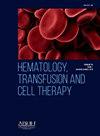HLA-DR-DQ associations, combined with PLASMIC score, are reliable predictors of acquired thrombotic thrombocytopenic purpura (aTTP) and aid in differentiating aTTP from other thrombotic microangiopathies
IF 1.8
Q3 HEMATOLOGY
引用次数: 0
Abstract
Background
Thrombotic microangiopathies (TMA) are a group of disorders with overlapping clinical features that require urgent intervention. Treatment is based on the recognition of the TMA type, which is often challenging. The aim of this study was to identify specific HLA associations with different TMA types to aid rapid diagnosis and appropriate treatment, since the HLA assay can be completed within five hours.
Methods
All 86 consecutive patients who presented to the University of Arkansas for Medical Sciences between May 2013 and January 2021 with a presumptive diagnosis of TMA were included in this study. HLA typing was performed and correlated with other clinical and laboratory studies.
Results
In comparison with other types of TMA, patients with acquired thrombotic thrombocytopenic purpura (aTTP) showed increased frequencies of HLA-DRB1*11, HLA-DQB1*03:01/19, HLA-DRB1*08 and HLA-DRB3. Combining the presence of these HLA associations with a PLASMIC score of 6 or more achieved a higher positive predictive value (90%) for identifying aTTP than the PLASMIC score alone (69%). In comparison with other TMA types, patients with aTTP showed decreased frequencies of HLA-DRB4, HLA-DRB1*07, HLA-DQB1*02. The HLA-DRB1*07/DQB1*02 was not observed in any aTTP patients (negative predictive value: 100%), and thus the presence of this haplotype essentially rules out aTTP. Further, HLA-DRB1*11/DQB1*03:01/19 was absent in atypical hemolytic uremic syndrome patients.
Conclusion
HLA alleles can be used as an adjunct for the rapid assessment of TMA and can help to differentiate it from other primary and secondary forms of TMA, allowing for earlier definitive therapy.
HLA-DR-DQ 关联与 PLASMIC 评分相结合,是获得性血栓性血小板减少性紫癜(aTTP)的可靠预测指标,有助于区分 aTTP 和其他血栓性微血管病
血栓性微血管病变(TMA)是一组具有重叠临床特征的疾病,需要紧急干预。治疗是基于对TMA类型的识别,这通常是具有挑战性的。由于HLA检测可在5小时内完成,本研究的目的是确定不同TMA类型与特定HLA的相关性,以帮助快速诊断和适当治疗。方法2013年5月至2021年1月期间在阿肯色大学医学科学学院就诊的推定诊断为TMA的86例连续患者纳入本研究。进行HLA分型,并与其他临床和实验室研究相关联。结果获得性血栓性血小板减少性紫癜(aTTP)患者HLA-DRB1*11、HLA-DQB1*03:01/19、HLA-DRB1*08和HLA-DRB3的表达频率高于其他TMA类型。将这些HLA相关性与血浆评分6分或以上相结合,在识别aTTP方面的阳性预测值(90%)高于单独血浆评分(69%)。与其他TMA类型相比,aTTP患者HLA-DRB4、HLA-DRB1*07、HLA-DQB1*02的频率降低。在所有aTTP患者中未观察到HLA-DRB1*07/DQB1*02(阴性预测值为100%),因此该单倍型的存在基本上排除了aTTP。HLA-DRB1*11/DQB1*03:01/19在非典型溶血性尿毒症患者中缺失。结论hla等位基因可作为快速评估TMA的辅助手段,有助于将其与其他原发性和继发性TMA区分开来,从而有助于早期确定治疗。
本文章由计算机程序翻译,如有差异,请以英文原文为准。
求助全文
约1分钟内获得全文
求助全文
来源期刊

Hematology, Transfusion and Cell Therapy
Multiple-
CiteScore
2.40
自引率
4.80%
发文量
1419
审稿时长
30 weeks
 求助内容:
求助内容: 应助结果提醒方式:
应助结果提醒方式:


